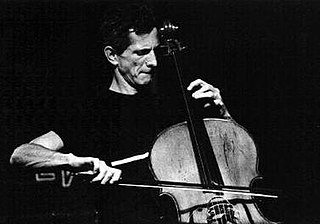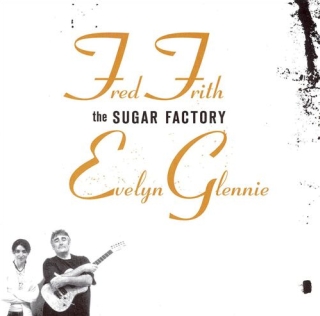
Miya Masaoka is an American composer, musician, and sound artist active in the field of contemporary classical music and experimental music. Her work encompasses contemporary classical composition, improvisation, electroacoustic music, inter-disciplinary sound art, sound installation, traditional Japanese instruments, and performance art. She is based in New York City.

Dame Evelyn Elizabeth Annie Glennie, is a Scottish percussionist. She was selected as one of the two laureates for the Polar Music Prize of 2015.

Jeremy Webster "Fred" Frith is an English multi-instrumentalist, composer, and improviser. Probably best known for his guitar work, Frith first came to attention as a founding member of the English avant-rock group Henry Cow. He was also a member of the groups Art Bears, Massacre, and Skeleton Crew. He has collaborated with a number of prominent musicians, including Robert Wyatt, Derek Bailey, the Residents, Lol Coxhill, John Zorn, Brian Eno, Mike Patton, Lars Hollmer, Bill Laswell, Iva Bittová, Jad Fair, Kramer, the ARTE Quartett, and Bob Ostertag. He has also composed several long works, including Traffic Continues and Freedom in Fragments. Frith produces most of his own music, and has also produced many albums by other musicians, including Curlew, the Muffins, Etron Fou Leloublan, and Orthotonics.

Ikue Mori, also known as Ikue Ile, is a drummer, electronic musician, composer, and graphic designer. Mori was awarded a "Genius grant" from the MacArthur Foundation in 2022.

Thomas Henry Corra, better known as Tom Cora, was an American cellist and composer, best known for his improvisational performances in the field of experimental jazz and rock. He recorded with John Zorn, Butch Morris, and the Ex, and was a member of Curlew, Third Person and Skeleton Crew.

John Psathas, is a New Zealand Greek composer. He has works in the repertoire of such high-profile musicians as Evelyn Glennie, Michael Houstoun, Michael Brecker, Joshua Redman and the New Juilliard Ensemble, and is one of New Zealand's most frequently performed composers. He has established an international profile and receives regular commissions from organisations in New Zealand and overseas.

Chris Cutler is an English percussionist, composer, lyricist and music theorist. Best known for his work with English avant-rock group Henry Cow, Cutler was also a member and drummer of other bands, including Art Bears, News from Babel, Pere Ubu and (briefly) Gong/Mothergong. He has collaborated with many musicians and groups, including Fred Frith, Lindsay Cooper, Zeena Parkins, Peter Blegvad, Telectu and The Residents, and has appeared on over 100 recordings. Cutler's career spans over four decades and he still performs actively throughout the world.

It's All Gone Pete Tong is a 2004 British-Canadian mockumentary-drama film about a DJ who goes completely deaf. The title uses a rhyming slang phrase used in Britain from the 1980s, referring to the BBC Radio 1 DJ Pete Tong who cameos in the film.

Rivers and Tides is a 2001 documentary film directed by Thomas Riedelsheimer about the British artist Andy Goldsworthy, who creates intricate and ephemeral sculptures from natural materials such as rocks, leaves, flowers, and icicles. The music was composed and performed by Fred Frith and was released on a soundtrack, Rivers and Tides (2003).

Sound and Fury is a documentary film released in 2000 about two American families with young deaf children and their conflict over whether or not to give their children cochlear implants, surgically implanted devices that may improve their ability to hear but may threaten their Deaf identity.

Step Across the Border is a 1990 avant-garde documentary film on English guitarist, composer and improviser Fred Frith. It was written and directed by Nicolas Humbert and Werner Penzel and released in Germany and Switzerland. The film was screened in cinemas in North America, South America, Europe and Japan, and on television in the United States, Germany, Switzerland, Austria and France. It was also released on VHS by RecRec Music (Switzerland) in 1990, and was later released on DVD by Winter & Winter Records (Germany) in 2003.

Rivers and Tides: Working with Time is a soundtrack by English guitarist, composer and improvisor Fred Frith, of the 2001 Anglo-German documentary film, Rivers and Tides by Thomas Riedelsheimer about the British landscape sculptor Andy Goldsworthy.
Sugar factory may refer to:
Laura Anne Karpman is an American composer, whose work has included music for film, television, video games, theater, and the concert hall. She has won five Emmy Awards for her work. Karpman was trained at the Juilliard School, where she played jazz by day and honed her skills scatting in bars at night.
Love Is Never Silent is an American drama television film that premiered on NBC on December 9, 1985, as part of the Hallmark Hall of Fame anthology series. It is directed by Joseph Sargent and written by Darlene Craviotto, based on the novel In This Sign by Joanne Greenberg. The film stars Mare Winningham, Phyllis Frelich, Ed Waterstreet, Fredric Lehne, Cloris Leachman, and Sid Caesar. It follows a young woman who struggles with her own need for independence and the obligation she feels for her deaf parents.

Touch the Sound is a soundtrack by Scottish percussionist Evelyn Glennie of the 2004 documentary film Touch the Sound by German filmmaker Thomas Riedelsheimer about Glennie, who is profoundly deaf. It was released on CD in 2004 by German record label, Normal.

The Sugar Factory is a 2007 collaborative album by English experimental musician Fred Frith and Scottish percussionist Evelyn Glennie. It comprises material drawn from improvisations by Frith and Glennie recorded during the making of the 2004 documentary film Touch the Sound about Glennie, who is profoundly deaf. The album was released in 2007 in the United States by Tzadik Records as part of their "Key Series".

Debut Live is a live album by Icelandic singer Björk. While featuring live versions of songs from Debut, the album does not feature the songs as performed during the Debut tour from 1993–1994. Instead the majority of the CD comes from an acoustic performance of Debut on the MTV Unplugged television program. Originally released in the 5 disc Live Box set in 2003, Debut Live was later released separately on 1 June 2004 by One Little Indian records.

A Quiet Place is a 2018 American post-apocalyptic horror film directed by John Krasinski. The screenplay was written by Scott Beck and Bryan Woods from a story they conceived, with contributions by Krasinski after he joined the project. The plot revolves around a mother and father (Krasinski) who struggle to survive and raise their children in a post-apocalyptic world inhabited by blind extraterrestrial creatures with an acute sense of hearing.
The Aluphone is a tuned percussion instrument consisting of aluminum bells that are struck with a mallet to produce musical tones. In its standard configuration, the bells of the Aluphone are mounted on a frame, but it can also be played as a single handheld bell or as a stack of bells. The bells of the Aluphone are very durable, so they can be struck with a large variety of mallets, wands, or hammers depending on the tone that the musician seeks to produce.
















